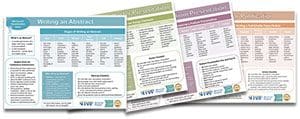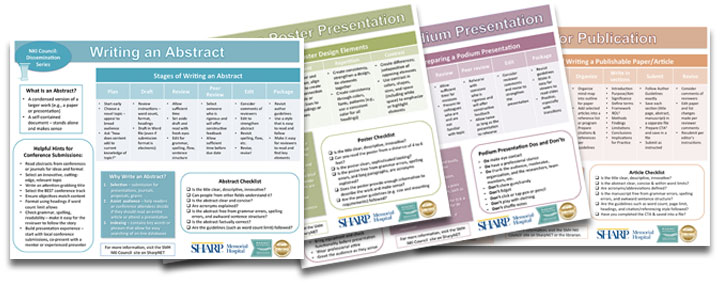Using information sheets allowed this organization to achieve its dissemination goals.
Takeaways:
- Dissemination information sheets can improve the quality of abstracts, manuscripts, and presentations.
- Kirkpatrick’s Model is a useful framework to guide evaluation of educational initiatives.
- Intentional strategies to support dissemination activities can help organizations achieve desired goals.
By Laurie Ecoff, PhD, RN, NEA-BC, and Elizabeth Kozub, MS, RN, CCNS, CCRN, CNRN
At the end of a study or project, you want to disseminate information and findings to a specific internal or external audience. You might do that through a manuscript, podium or poster presentation, or another form of media. No matter the form of dissemination, you’ll probably be asked to submit an abstract—a concise summary of your study or project.
Using effective strategies and formats to write abstracts and manuscripts increases their quality and the likelihood they’ll be accepted at conferences or in journals. And if an abstract is accepted for a conference, you’ll want to create an engaging poster and podium presentation to share your findings.
This article offers strategies for nurses and organizations to successfully disseminate information based on our experience at Magnet®-recognized Sharp Memorial Hospital. We used two frameworks, Donabedian’s Model of Healthcare Quality (structure, process, and outcome) and Kirkpatrick’s Model of Four Levels of Evaluation, to develop, implement, and evaluate a series of dissemination information sheets.
Structure-process-outcome
Donabedian’s model is a conceptual framework that uses structures, processes, and outcomes to evaluate healthcare quality. Structures include characteristics of the organization, such as leadership, resources, and models. Processes are actions taken to deliver nursing and healthcare programs or services. Outcomes are predetermined quantitative and qualitative measures of success that depend on established structures and processes. We used this framework to develop and evaluate our dissemination program.


Structure
Our new knowledge and innovation (NKI) council oversees research and dissemination using related sources of evidence (SOE) or standards. One standard, from the Magnet Recognition Program®, requires dissemination of new knowledge or research findings by clinical nurses. A baseline assessment of dissemination activities prompted the council to develop a series of information sheets to increase the quantity and quality of abstract and manuscript submissions and podium and poster presentations. The council already offered classes and mentoring on the topics; however, council members determined, based on class attendance by clinical nurses and anecdotal feedback, that electronically posted information sheets would increase clinical nurses’ accessibility. (Click to view Sharp’s sample information sheets.)
The information sheet template, designed to cover pertinent information on one letter-sized, landscape-oriented PowerPoint slide, has five sections that vary based on the type of dissemination:
- Definition of the type of dissemination with examples
- Development stages for abstracts, presentations, or publications, and design elements
- Prepresentation or prepublication review checklist, which can be used by the individual preparing the presentation or publication or by a colleague for peer-review and feedback
- Helpful hints or overall formatting tips
- Why the type of dissemination is important, or tips for success.
Process
The NKI council developed a communication plan that included educating all hospital councils about the dissemination series. To spread awareness, council members developed a concise explanation about the importance of the initiative. (See Elevator speech.)
Elevator speechThe new knowledge and innovation (NKI) council developed a short explanation to help others within the organization understand the importance of the dissemination information sheets. |
The council continued to offer classes on each of the dissemination topics, group education and mentoring sessions, and one-to-one mentoring. The dissemination information sheets not only helped nurses develop a plan to share projects and results, but also provided a guide by which to mentor and give feedback to class participants.
Outcome
The NKI council used Kirkpatrick’s four-level evaluation model to evaluate the dissemination series and information sheets.
• Level 1—Participant reaction. Evaluations at the conclusion of teaching and mentoring provided feedback for instructors and mentors, who adjusted course content and updated the dissemination series and information sheets.
• Level 2—Participant acquisition of knowledge, skills, and attitudes. These evaluations occurred during class activities and mentoring sessions and consisted of observing the participant’s ability to successfully demonstrate knowledge and skills related to the specific dissemination activity (for example, concept mapping, abstract drafts, presentation and poster development).
• Level 3—Behavior change or application in the practice setting. The third evaluation occurred during a final review of the abstracts and manuscripts submitted after participants incorporated mentor feedback and further developed drafts in the level 2 evaluation.
• Level 4—Results and outcomes of the education or course. Results and outcomes were evaluated through acceptance of abstracts and manuscripts and podium and poster presentations.
Clinical nurse dissemination of research and other scholarly activities increased from two in 2013 and two in 2014 to 15 in 2016. Overall dissemination by nurses at all levels in the organization improved from 32 in 2012 to 60 in 2016.
Lessons learned
Identifying barriers and facilitators to dissemination can help organizations and research councils develop creative strategies and solutions. In our organization, barriers to dissemination included the costs related to present (material cost, registration, and travel); time required to write abstracts, presentations, and manuscripts; competitive abstract and manuscript acceptance; and conflicting priorities. Facilitators to dissemination included carefully selecting conferences and journals, mentoring novice writers and submitters, creating funding sources, and scheduling consistent time to work on dissemination activities.
Creating strategies, achieving goals
Offering a dissemination series along with corresponding information sheets resulted in high-quality abstracts, manuscripts, and presentations and helped us achieve internal and external dissemination goals. From an organizational perspective, identifying lessons learned, including facilitators and barriers to dissemination, allowed us to create strategies to promote dissemination.
Laurie Ecoff is director of research, education, and professional practice at Sharp Memorial Hospital in San Diego, California. Elizabeth Kozub was a clinical nurse specialist at Sharp Memorial Hospital in the surgical intensive care unit at the time of manuscript submission and is now a clinical nurse specialist at Abbott Northwestern Hospital in Minneapolis, Minnesota.
Selected References
American Nurses Credentialing Center. The Magnet® Model Components and Sources of Evidence. Silver Spring, MD; 2013.
Donabedian A. The Definition of Quality and Approaches to Its Assessment. Ann Arbor, MI: Health Administration Press; 1980.
Donabedian A. An Introduction to Quality Assurance in Health Care. New York: Oxford University Press; 2003.
Kirkpatrick JD, Kirkpatrick WK. Kirkpatrick’s Four Levels of Training Evaluation. Alexandria, VA: ATD Press; 2016.
Schillinger D. An Introduction to Effectiveness, Dissemination and Implementation Research. 2010. accelerate.ucsf.edu/files/CE/edi_introguide.pdf
Magnet Stories ANT September Journal


















